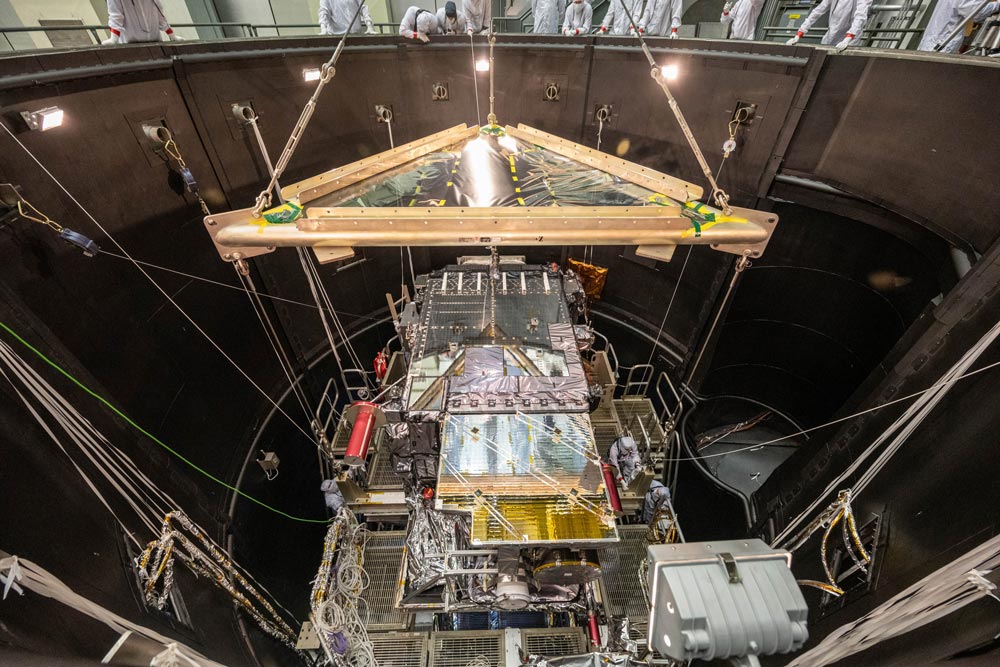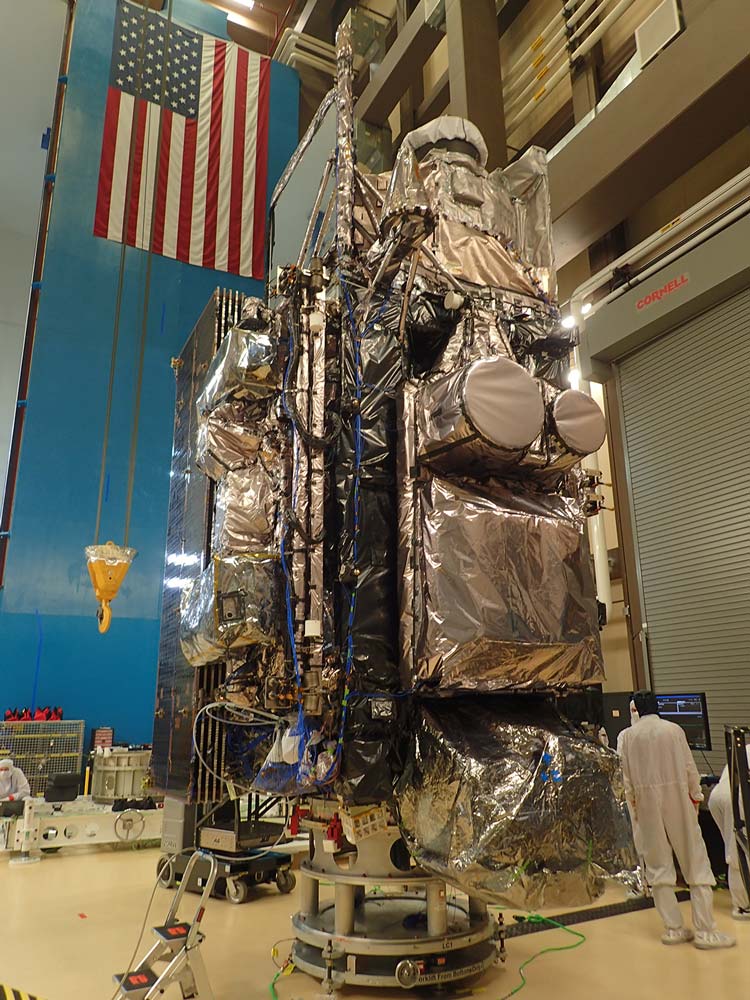
NOAA’s GOES-T Completes Critical Testing in Preparation for December 2021 Launch
March 22, 2021
NOAA’s GOES-T, the third in a series of advanced geostationary weather satellites, recently completed rigorous testing to ensure it can withstand the harsh conditions of launch and orbiting in space 22,236 miles above Earth.
During thermal vacuum testing, GOES-T was placed in a large 29 feet x 65 feet chamber and subjected to a vast range of temperatures, soaring as high as 188 degrees Fahrenheit (87 degrees Celsius) and dropping as low as minus 67 degrees Fahrenheit (minus 55 degrees Celsius) to simulate the extreme temperatures of launch and the space environment.

In February, GOES-T completed vibration testing, which mimics the stresses it will experience during launch to ensure the spacecraft doesn’t have structural weaknesses. GOES-T then endured extremely high sound pressure of 138.4 decibels from high-intensity horns during acoustic testing. This testing simulated the noises GOES-T will experience when it is launched. Finally, shock testing ensured the spacecraft can withstand the shocks encountered during separation from the launch vehicle and deployment of the satellite’s solar panels. These tests ensure that the spacecraft and all of its instruments can endure the launch and maintain functionality in orbit. Lockheed Martin and United Launch Alliance personnel conducted the testing at the Lockheed Martin Littleton, Colorado, facility where the spacecraft was built.
While the satellite was undergoing testing to prepare it for the physical conditions of launch and space, the GOES-T mission operations team conducted critical activities to test communications between the satellite and ground system and rehearse launch procedures.
The mission operations team continues to perform end-to-end tests that command the spacecraft (located in Denver) from the ground system (located in Maryland). The end-to-end tests validate the compatibility of space and ground hardware, software, and communications interfaces in a mission operations context. Most recently, the team conducted testing to verify the new Goddard Magnetometer (GMAG) instrument that will fly on GOES-T. The GOES-T and GOES-U satellites will carry an upgraded magnetometer instrument from the one aboard GOES-16 and GOES-17. GMAG is expected to provide improved performance to meet mission requirements. The magnetometer measures magnetic field variations that are associated with space weather.
The mission operations team conducted the first GOES-T mission rehearsal in February. Mission rehearsals use a satellite simulator and the ground system to train operations personnel and test the readiness of operational products and the ground system. These simulations help test different parts of launch, like orbit-raising, post-launch separation events, solar array deployment, and propulsion system readiness. They simulate both normal operations and what to do if a procedure doesn’t go as planned. The GOES-T team will hold six mission rehearsals before launch.
The mission operations team has put new safety, social-distancing, and remote access procedures in place to keep personnel safe during the COVID-19 pandemic. The team is using a new remote access system to minimize travel and staffing at the NOAA Satellite Operations Facility during mission preparation activities.

GOES-T is on track for a December 2021 launch from Cape Canaveral Air Force Station in Florida. The satellite will be renamed GOES-18 once it reaches geostationary orbit. Once GOES-18 completes on-orbit checkout of its instruments and systems, NOAA will consider the health and reliability of the overall GOES observing system before deciding whether GOES-18 will reside in on-orbit storage or go immediately into operational service.
NOAA’s GOES-R satellites comprise the Western Hemisphere’s most advanced weather-observing and environmental-monitoring system. The GOES-R Program is a four-satellite mission that includes GOES-R (GOES-16, launched in 2016), GOES-S (GOES-17, launched in 2018), GOES-T and GOES-U, planned for launch in 2024.
The GOES-R Series satellites are planned for operation into the 2030s. Meanwhile, NOAA is beginning work on the next-generation geostationary mission called Geostationary and Extended Orbits (GEO-XO). GEO-XO will continue the observations provided by GOES-R and also bring new capabilities to address major environmental challenges of the future in support of U.S. weather, ocean and climate operations.
The GOES-R and GEO-XO Programs are collaborative efforts between NOAA and NASA. NASA builds and launches the satellites for NOAA, which operates them and distributes their data to users worldwide. The satellites provide critical data for weather forecasts and warnings, detection and monitoring of environmental hazards like fire, smoke, fog, volcanic ash, and dust, and monitoring of solar activity and space weather.